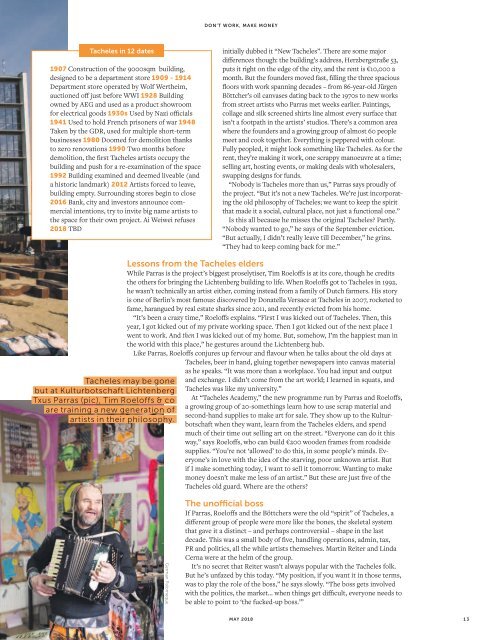You also want an ePaper? Increase the reach of your titles
YUMPU automatically turns print PDFs into web optimized ePapers that Google loves.
DON’T WORK, MAKE MONEY<br />
Tacheles in 12 dates<br />
1907 Construction of the 9000sqm building,<br />
designed to be a department store 1909 - 1914<br />
Department store operated by Wolf Wertheim,<br />
auctioned off just before WWI 1928 Building<br />
owned by AEG and used as a product showroom<br />
for electrical goods 1930s Used by Nazi officials<br />
1941 Used to hold French prisoners of war 1948<br />
Taken by the GDR, used for multiple short-term<br />
businesses 1980 Doomed for demolition thanks<br />
to zero renovations 1990 Two months before<br />
demolition, the first Tacheles artists occupy the<br />
building and push for a re-examination of the space<br />
1992 Building examined and deemed liveable (and<br />
a historic landmark) 2012 Artists forced to leave,<br />
building empty. Surrounding stores begin to close<br />
2016 Bank, city and investors announce commercial<br />
intentions, try to invite big name artists to<br />
the space for their own project. Ai Weiwei refuses<br />
<strong>2018</strong> TBD<br />
initially dubbed it “New Tacheles”. There are some major<br />
differences though: the building’s address, Herzbergstraße 53,<br />
puts it right on the edge of the city, and the rent is €10,000 a<br />
month. But the founders moved fast, filling the three spacious<br />
floors with work spanning decades – from 86-year-old Jürgen<br />
Böttcher’s oil canvases dating back to the 1970s to new works<br />
from street artists who Parras met weeks earlier. Paintings,<br />
collage and silk screened shirts line almost every surface that<br />
isn’t a footpath in the artists’ studios. There’s a common area<br />
where the founders and a growing group of almost 60 people<br />
meet and cook together. Everything is peppered with colour.<br />
Fully peopled, it might look something like Tacheles. As for the<br />
rent, they’re making it work, one scrappy manoeuvre at a time;<br />
selling art, hosting events, or making deals with wholesalers,<br />
swapping designs for funds.<br />
“Nobody is Tacheles more than us,” Parras says proudly of<br />
the project. “But it’s not a new Tacheles. We’re just incorporating<br />
the old philosophy of Tacheles; we want to keep the spirit<br />
that made it a social, cultural place, not just a functional one.”<br />
Is this all because he misses the original Tacheles? Partly.<br />
“Nobody wanted to go,” he says of the September eviction.<br />
“But actually, I didn’t really leave till December,” he grins.<br />
“They had to keep coming back for me.”<br />
Tacheles may be gone<br />
but at Kulturbotschaft Lichtenberg<br />
Txus Parras (pic), Tim Roeloffs & co<br />
are training a new generation of<br />
artists in their philosophy.<br />
Lessons from the Tacheles elders<br />
While Parras is the project’s biggest proselytiser, Tim Roeloffs is at its core, though he credits<br />
the others for bringing the Lichtenberg building to life. When Roeloffs got to Tacheles in 1992,<br />
he wasn’t technically an artist either, coming instead from a family of Dutch farmers. His story<br />
is one of Berlin’s most famous: discovered by Donatella Versace at Tacheles in 2007, rocketed to<br />
fame, harangued by real estate sharks since 2011, and recently evicted from his home.<br />
“It’s been a crazy time,” Roeloffs explains. “First I was kicked out of Tacheles. Then, this<br />
year, I got kicked out of my private working space. Then I got kicked out of the next place I<br />
went to work. And then I was kicked out of my home. But, somehow, I’m the happiest man in<br />
the world with this place,” he gestures around the Lichtenberg hub.<br />
Like Parras, Roeloffs conjures up fervour and flavour when he talks about the old days at<br />
Tacheles, beer in hand, gluing together newspapers into canvas material<br />
as he speaks. “It was more than a workplace. You had input and output<br />
and exchange. I didn’t come from the art world; I learned in squats, and<br />
Tacheles was like my university.”<br />
At “Tacheles Academy,” the new programme run by Parras and Roeloffs,<br />
a growing group of 20-somethings learn how to use scrap material and<br />
second-hand supplies to make art for sale. They show up to the Kulturbotschaft<br />
when they want, learn from the Tacheles elders, and spend<br />
much of their time out selling art on the street. “Everyone can do it this<br />
way,” says Roeloffs, who can build €200 wooden frames from roadside<br />
supplies. “You’re not ‘allowed’ to do this, in some people’s minds. Everyone’s<br />
in love with the idea of the starving, poor unknown artist. But<br />
if I make something today, I want to sell it tomorrow. Wanting to make<br />
money doesn’t make me less of an artist.” But these are just five of the<br />
Tacheles old guard. Where are the others?<br />
German Palomeque<br />
The unofficial boss<br />
If Parras, Roeloffs and the Böttchers were the old “spirit” of Tacheles, a<br />
different group of people were more like the bones, the skeletal system<br />
that gave it a distinct – and perhaps controversial – shape in the last<br />
decade. This was a small body of five, handling operations, admin, tax,<br />
PR and politics, all the while artists themselves. Martin Reiter and Linda<br />
Cerna were at the helm of the group.<br />
It’s no secret that Reiter wasn’t always popular with the Tacheles folk.<br />
But he’s unfazed by this today. “My position, if you want it in those terms,<br />
was to play the role of the boss,” he says slowly. “The boss gets involved<br />
with the politics, the market… when things get difficult, everyone needs to<br />
be able to point to ‘the fucked-up boss.’”<br />
MAY <strong>2018</strong><br />
13

















